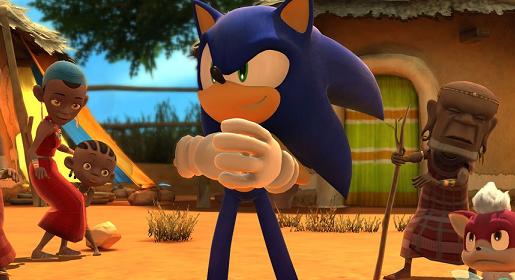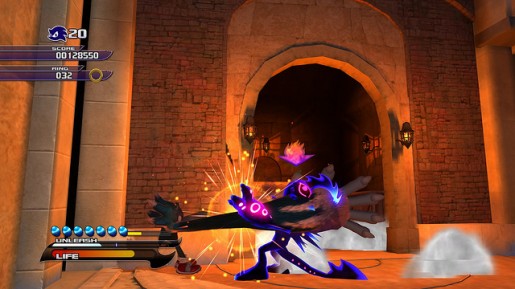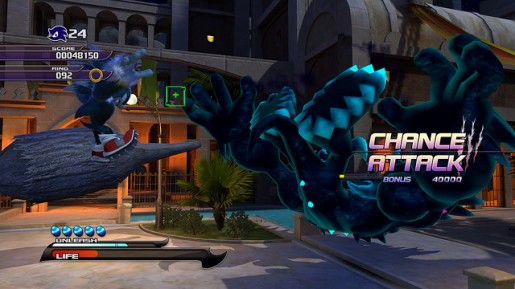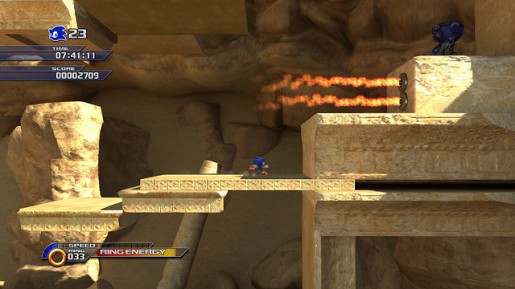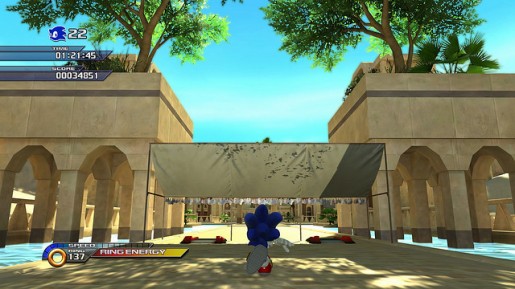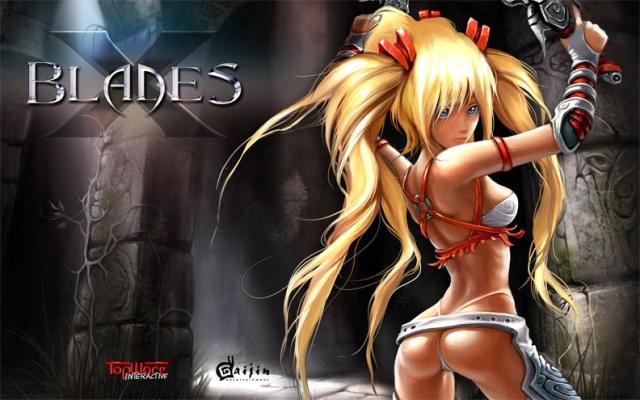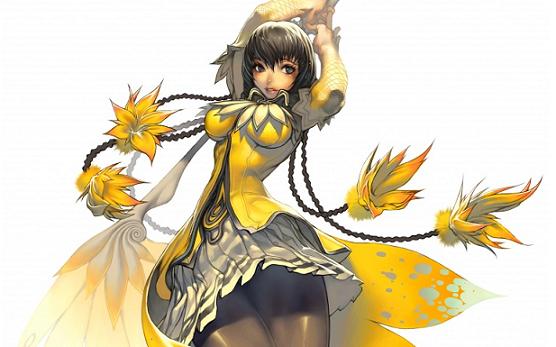Platforms: Microsoft Xbox 360, Sony PlayStation 3
Developer: Sonic Team – Publisher: SEGA
Genre: Action/Adventure/Platformer
ESRB Rating: “E10+” for Everyone Ages 10 and Up
Over the past year or two I’ve grown up in a number of ways, some of which might qualify as life-changing epiphanies or world-shattering realizations that completely change the way I look at the world. The one that’s relevant to this review is utterly inconsequential: I realized that I was too damn defensive about games that I’m determined from the off to enjoy.
I think, actually, that a lot of gamers share this problem, and many of those that don’t fall into the opposite side of the ballpark: the side that focuses too much on a game’s flaws without acknowledging enough of what was good about it. It’s a textbook glass-half-empty, glass-half-full psychology, I think, but as someone who would quite like to review videogames professionally (and, if possible, by way of actual profession), the revelation that I am simply too forgiving just made me want to head-desk. I didn’t, of course, not being a fan of bumps to the head. But you get the picture.
When SEGA first released Sonic Unleashed (poetry unintended), I was obsessing over it on the SEGA forums. Like many fans of the time, I was, in my own way, still reeling from the massive wad of fail that SEGA had seen fit to dub Sonic the Hedgehog back in 2006. My own particular way of doing this might be identified by an adept psychologist as the root of all that is the Sonic Cycle: I was so fixated on the next game in the series being good that I was determined to see it as such. So, I villainized professional reviewers who derided the game (mind you, the IGN and GameSpot reviews are still embarrassingly bad at what they do, but my reasons for saying that now aren’t so biased). I churned out an overlong, overwordy review in defense of the game. To my credit, I acknowledged a number of its key flaws. But the tone of it was unmistakable: “I want this game to be good, so I’m saying that it’s good!”
…Which is exactly why I’m reviewing the game for a second time just now. Consider the above monologue a retraction of sorts.
But don’t misunderstand: I am not, per se, throwing my lot in with the likes of Ben “Yahtzee” Croshaw or IGN’s Hilary Goldstein. Quality isn’t so black-and-white that any game that isn’t “great” automatically gets filed away in the “fail” folder. Sonic Unleashed is, I realize, a sublimely average game that looks pretty and is only remarkable in any way because the Day Stage gameplay is unique to the franchise. Sonic is the only character to have played quite this way, so it’s impossible to say that “you can get this kind of gameplay from another game, only done better” — which is, I’m sure most would agree, the main reason why “average” games aren’t often worth playing.
The most obvious problems with this game are still the most obvious points that I brought up in my previous review: the Werehog stages that dominate the majority of gametime, and the gods-damned medals. The Werehog itself (let’s not waste time nitpicking the etymology of the word “Werehog” as if doing so is somehow clever or witty, ’kay?) is a bread-and-butter God of War clone, and the issue I mentioned above does indeed apply. You can get the same gameplay, done infinitely better, from other games (God of War, Dante’s Inferno, Castlevania: Lords of Shadow, and probably a number of others as well). It’s not quite what I’d call “bad,” it’s just wholly unremarkable and in no way unique enough to make up for it. Is it any surprise that players who had already been exposed to modern beat-‘em-ups lost interest so quickly?
The medals are a more fundamental issue, a classic case of collectible-based stage progression gone horribly wrong. You need to collect a specific number of Sun Medals and Moon Medals to unlock each successive stage in the game, and by the end of the game the requirements are unreasonably high. These medals are scattered throughout the stages, often in clever hiding places, and the majority of them are in the Werehog stages (which makes sense; the high-octane speed stages don’t exactly present the most optimal stage setup for exploration). The upshot is that you spend more time playing stages you’ve already finished than actually progressing to new content. Tedious design like this artificially lengthens playtime, and when playtime is lengthened in such a way, it inevitably leads to player frustration. This is unforgivably bad game design, and is the only flaw in this game that I honestly can’t find any valid defense for.
One complaint that often comes up when people talk about Sonic Unleashed is the hub-world, but I think this is more people projecting a lingering hatred of 2006’s Soleanna onto the world of Unleashed. This game’s hub world is both utterly unremarkable—completely average in every single way—and unobtrusive enough that it doesn’t matter whether it exists or not. I did defend this in my original review, but having played through the game again recently, I realize that for every ounce of charm this hub contains, it holds equal portions of “There is simply no reason you should give a crap.” You walk around quaint little town sections and talk to people. You walk around little stage-portal hubs and enter stages. There are a few collectibles sprinkled hither and thither, but not enough to eat up more than a few minutes of your time. Townsfolk sometimes give you missions to accomplish, some of which are good, most of which are pointless, none of which are worth complaining about, all of which are entirely optional. The hubs do the game no real credit, but neither do they do it any harm. They’re just… there. They exist, therefore they exist. And that’s all that the great sage and eminent orange soda addict, Solaris Paradox, has to say on the subject.
So, then, the real attraction here is those day stages I mentioned, right? I like ‘em, but having played them to death and gotten over the novelty, all I can say is that they make for a nice rush, but lack the spice of life. You know… that little aspect called “variety.” The most interesting thing that ever happens during a Day Stage is the ice level’s “Surprise! You’re in a bobsled!” segments, which are fun, brief, and the only spark of life that Sonic Unleashed has on offer in terms of stage design. (The designers must have realized this, because the bobsled returns for an encore in the game’s punishingly-difficult final stage.)
Each stage is, in essence, a slightly-more-challenging version of the previous: you run really, really fast, boost through tons of stuff, side-step a lot, occasionally drift through a turn (Sonic does play somewhat like a racecar in this regard), grind on too many rails, and spend a lot of time watching Sonic run through loops and corkscrews and other manner of “Yeowza, that’s awesome!” set-pieces, usually with the aid of more dash-pads than any Sonic the Hedgehog level should ever have, want, or need. It’s a peculiar combination of gameplay and non-gameplay — if I had to peg the style introduced in Sonic Unleashed with any one key flaw, it would be an overemphasize on cinematics and an underemphasis on actual gameplay. The stages are flashy, linear, and, ultimately, too simplistic for their own good.
The Day Stages offer the “let’s try our darnedest to reel in the old-school crowd” gimmick of switching back-and-forth between a behind-the-back perspective and a 2D-sidescroller perspective. While this is a neat gimmick in theory, I don’t think Unleashed used it to its proper potential (Sonic Colors did so more admirably, but still has a ways to go). I’m talking, of course, of what makes Sonic work so well in 2D. You see, I have no aversion to speed-centric stage design in a 3D perspective. If anything, being able to see what’s in front of Sonic opens up new avenues for the designers to throw more and more complex stage designs at the player without slowing the pace of the level to do so. The 2D sections, however, are very much akin to Sonic Rush on the Nintendo DS; you boost, you occasionally use memorization to jump into a shortcut, score ring, or some such, and mostly you just see Sonic run. What works for Sonic in 2D is what worked for Sonic back in his 2D days: speed, physics, and platforming. Unleashed’s 2D segments contain far too much of one, not enough of another, and totally screw the pooch on the one in-between.
Optional and downloadable stages offer some of the variety that the main-story levels lack, but usually at the cost of making obvious some flaw in the gameplay that rarely, if ever, poses a problem in the main game (because it sticks to what the style actually does well). An optional level might offer an abundance of 3D platforming; this only succeeds in making Sonic’s less-than-optimal directional control more of a hindrance. An optional stage might offer a lot of 2D platforming; this only succeeds in exposing how jerky and uncontrollable his jumps are. An optional stage might involve a lot of 2D speed-jumping and reflex reaction; this only exposes how little time the 2D segments give you to react to things at all.
There are other issues I could go on about — I’m a particular fan of raging about how annoying the abundance of “quick-time events” are in this game (there’s a really drawn-out minigame that the player is forced to endure twice, which is nothing more or less than one long QTE), or how cheap the instant-kill QTEs, which litter optional levels and late-game story stages, can be. There’s the game’s over-reliance on bottomless pits, and alternately, water-running segments, which are bottomless pits that you can run over if you’re moving fast enough. There’s the story, which is actually decent, contrary to what you might have heard. There’s Chip, the game’s spritely one-off sidekick character (whether you find him charming, annoying, or simply “meh” like I do is a matter of personal taste).
The bottom line, however, is that what I saw in Sonic Unleashed when it came out was a game that is infinitely better than Sonic the Hedgehog 2006. What I see now is a game that is a massive step forward from ’06, but still a long ways from where the series needs to be to interest anyone who isn’t already a fan of Sonic the Hedgehog. It’s a game with potential but not enough worthwhile content, and with far too much other content that buries the underlying experience in a fog of mediocrity. It is, in short, what most of the non-cringeworthy naysay-reviews identified it as when it first came out.
I was just too much of a fanboy to notice at the time.
Ah, well, it’s like the song goes, right? “Live and learn…”
—
The above article was originally posted to SEGA HD on August 9, 2011.

